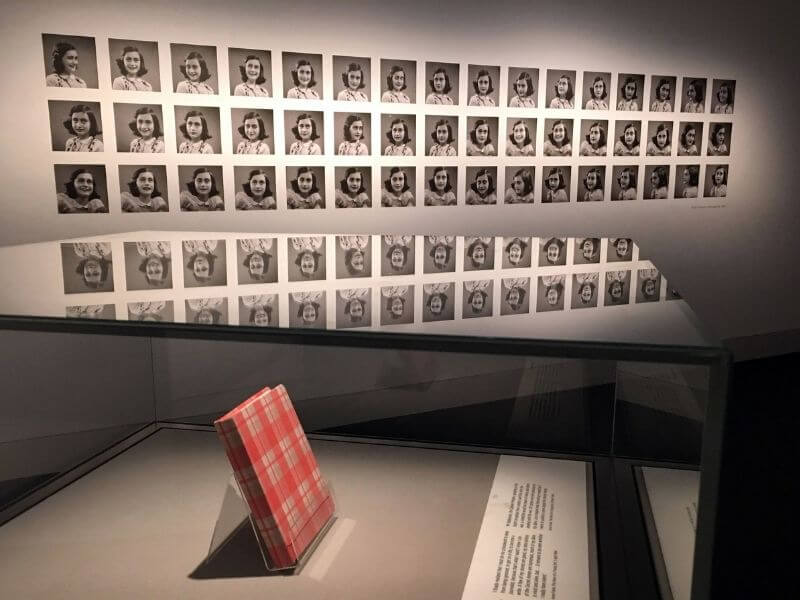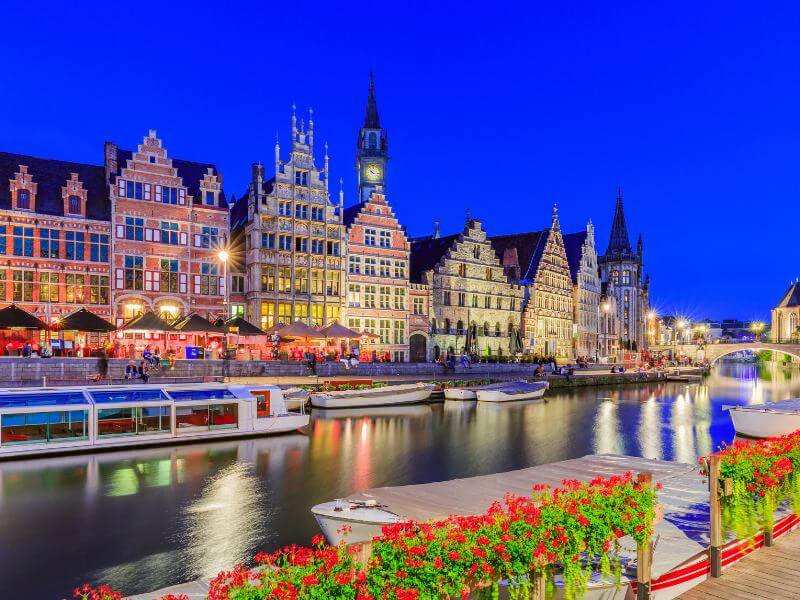
- - Updated on
Home » Anne Frank House
Visit the Anne Frank House in Amsterdam: A Memorable Experience
Nestled along the charming canals of Amsterdam, the Anne Frank House is a must-visit destination that beautifully weaves history with a profound narrative. Stepping into the very house where young Anne Frank penned her famous diary, you’re transported back to a time of hope amidst hardship.
This isn’t just any museum; it’s a moving journey through the secret annex that sheltered Anne and her family during World War II. As you wander through the hidden rooms, the whispers of the past feel remarkably present.
The original diary on display is a poignant reminder of resilience and the enduring human spirit. Whether you’re a history enthusiast or a curious traveler, a visit to the Anne Frank House offers an unforgettable experience that touches the heart.
So, when you’re exploring the vibrant streets of Amsterdam, make sure this iconic spot is on your itinerary! And for other great ideas and hot spots to visit in Amsterdam, be sure to check out my article, “Things to do in Amsterdam!”

A Step Back in Time
The Anne Frank House is the very place where Anne Frank, her family, and four others hid from Nazi persecution during World War II. For over two years, they lived in the Secret Annex, a hidden area behind a movable bookcase where Anne’s father, Otto Frank, had his business.
Walking through the narrow passages and steep staircases, visitors can feel the weight of history. The rooms are preserved to reflect the period of hiding, with original artifacts and photographs that bring the story to life. The walls still bear the marks of the Frank family’s presence, including Anne’s cherished movie star pictures that she pasted on her bedroom wall to brighten the confined hiding place.
The Museum Experience: Planning Your Visit and Tickets
The Anne Frank House is thoughtfully designed to guide visitors through the Frank family’s journey. The exhibition begins with the history of the Frank family, their move from Germany to Amsterdam to escape Nazi persecution, and their eventual need to go into hiding.
Multimedia displays, personal belongings, and historical documents enrich the narrative. The museum provides an audio guide in multiple languages, offering detailed explanations and personal stories that deepen the experience.
Tickets: Given its popularity, it is essential to plan your visit to the Anne Frank House in advance. Tickets are released online two months ahead and tend to sell out quickly. In order to buy your tickets, you must do this on the official website: www.annefrank.org
Opening Hours: The museum is generally open from 9:00 AM to 10:00 PM, but hours may vary depending on the season. For the most up-to-date information, check the official website.
Admission fees and Discounts for the Anne Frank House:
- Adults (18+): €16.00 (includes a €1.00 booking fee)
- Youth (10-17 years): €7.00 (includes a €1.00 booking fee)
- Children (0-9 years): €1.00 (includes a €1.00 booking fee)
- Discount for Museumkaart Holders: €1.00 (includes a €1.00 booking fee)
- Discount for ICOM Card Holders: €1.00 (includes a €1.00 booking fee)
- European Youth Card (EYC) Holders: €7.00 (includes a €1.00 booking fee)

Additional / Important Information:
The museum offers a 30-minute introductory program in English, providing historical context about Anne Frank and World War II. This program costs an additional €7.00 and is recommended for visitors aged 10 and above.
- Tickets are non-transferable and valid only on the specified date and time.
- Payments are accepted via bank or credit card.
- Be cautious of third-party vendors offering tickets, as the museum does not authorize resales, and such tickets may be invalid.
Anne Frank's Diary: A Voice That Echoes Through Time
At the heart of the museum is Anne Frank’s original diary. From June 12, 1942, until August 1, 1944, Anne recorded her thoughts, fears, and dreams in this red-checkered notebook. Her writing offers an intimate look into the life of a young Jewish girl who remained hopeful and introspective despite the circumstances.
The diary has been translated into more than 70 languages, making Anne’s Voice one of the most widely-read accounts of the Holocaust. Seeing the diary in person is a profound experience that connects visitors directly to Anne’s world.


The Secret Annex: A Hiding Place Revealed
The Secret Annex remained undiscovered for over two years, thanks to the bravery and ingenuity of Otto Frank’s employees who helped hide the families. The entrance to the annex was concealed behind a movable bookcase, which still stands today.
As you enter the annex, the atmosphere changes. The rooms are empty, as per Otto Frank’s wishes, symbolizing the void left by those who were taken to concentration camps. Yet, the emptiness speaks volumes. It’s a stark reminder of the lives interrupted and the innocence lost during the war.

Otto Frank: A Father's Legacy
Otto Frank was the only member of his immediate family to survive the Holocaust. After the war, he returned to Amsterdam and was given Anne’s diary by Miep Gies, one of the helpers who had preserved it. Recognizing the significance of his daughter’s writings, Otto dedicated himself to sharing her story with the world.
In 1960, the Anne Frank House was officially opened as a museum, mainly due to Otto’s efforts. He wanted the house to serve as a warning about the dangers of hatred and discrimination and as a place where people could reflect on the importance of human rights.
Visitor Tips
- Book Early: Secure your tickets as soon as they become available.
- Arrive On Time: Entry is only allowed during your designated time slot.
- Travel Light: Large bags are not permitted inside, and there are no locker facilities.
- No Photography: Photography is not allowed inside the museum to preserve the artifacts and maintain a respectful atmosphere.
- Audio Guide: For a richer experience, use the complimentary audio guide available in multiple languages.
- Prepare Emotionally: The museum deals with heavy subjects that can be emotionally taxing.
The Emotional Journey
Visiting the Anne Frank House is an emotional journey that leaves a lasting impact. The museum doesn’t shy away from the harsh realities of the war and the fate of the Jewish people during the Holocaust. Yet, it also highlights the strength of the human spirit and the importance of standing up against injustice.
A Place of Reflection and Education
The Anne Frank House serves not only as a memorial but also as an educational center. It hosts various exhibitions and educational programs aimed at raising awareness about antisemitism, racism, and the importance of freedom and equality.
Continuing the Conversation
By sharing Anne’s story, the museum encourages visitors to reflect on the past and consider how they can contribute to a more just and compassionate world. It reminds visitors that the lessons of history are still relevant today.
Exploring Amsterdam
After your visit, take some time to explore the charming Jordaan neighborhood. The area is filled with quaint cafes, boutique shops, and picturesque canals. It’s a great place to process your experience and enjoy the beauty of Amsterdam.
FAQ
Can I buy tickets at the museum entrance?
No, all tickets must be purchased online in advance. Tickets are not sold at the museum entrance.
Are guided tours available?
The museum does not offer guided tours. However, the audio guide, available in multiple languages, provides a comprehensive and informative experience.
How long should I plan for my visit?
Most visitors spend about 1 to 1.5 hours in the museum, but you may want to allocate extra time for the museum shop and personal reflection.
Is the Anne Frank House suitable for children?
Yes, but due to the sensitive and emotional content, it is recommended for children aged ten and older. Parents should use their discretion.
What languages is the audio guide available in?
The audio guide is available in Dutch, English, German, French, Spanish, Italian, Portuguese, Hebrew, and Japanese.
Can I take photos inside the museum?
No, photography and filming are not allowed inside the museum to protect the artifacts and maintain a respectful environment.
Is the Anne Frank House accessible to visitors with disabilities?
The new part of the museum is accessible, but due to its historical architecture, the Secret Annex is not wheelchair accessible. It has steep and narrow staircases that may be challenging for some visitors.
Are there facilities like restrooms and a cafe?
Yes, there are restrooms available. The museum also has a small cafe where you can enjoy refreshments after your visit.
Is there a place to store my luggage or large bags?
No, the museum does not have locker facilities. It’s best to leave your luggage at your accommodation or use storage facilities at train stations.
Can I buy Anne Frank's diary at the museum?
Yes, the museum shop sells the diary and other related books in various languages.
How can I get to the Anne Frank House using public transport?
You can reach the museum by taking tram lines 13 or 17 to the Westermarkt stop. From there, it’s a short walk to the museum.
What other attractions are nearby?
The museum is close to other popular attractions like the Westerkerk church and the Nine Streets shopping area.
Is the museum included in the I Amsterdam City Card or Museumkaart?
No, the Anne Frank House does not accept these cards. Tickets must be purchased separately online.

Editor: Hi! I’m Allie, and welcome to my travel blog. Born and raised in Texas and moved to Germany 8 years ago on a quest for self-discovery. Follow me on this great adventure as I’ll be your trusted travel guide, sharing my experiences, insights, and tips from my journeys around the globe.
Related articles:


